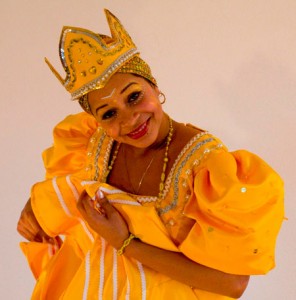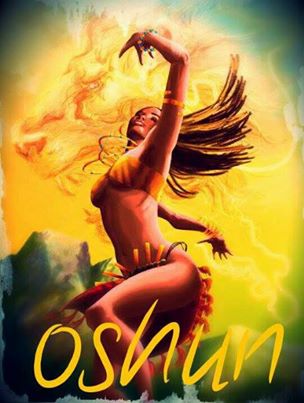SANTERÍA “OCHÚN-OSHUN “, ON AFRO-CUBAN FOLKLORE.
 OCHUN / OSHUN (Virgen de la Caridad del Cobre-Venus).
OCHUN / OSHUN (Virgen de la Caridad del Cobre-Venus).
Orisha greater. Owner of fresh water , rivers and springs. Orisha of femininity , sensuality and love. Goddess of honey , gold and money.
Orisha flirty and provocative , fire care home and the woman’s womb . Chango woman and close friend of Eleggua, that protects it. It is represented as a beautiful , sympathetic , good dancer , and eternally cheerful partying mulata . It is provocative and usually encourage fights between orishas and men.
OCHÚN PATAKI.
A fine Ochún liked walking through the woods, where dancing and singing , playing with animals and those who respected neither the scorpion stung . Oggún saw one day pass and was captivated by its beauty, helplessly chased to possess. Oshun that he loved was Chango , fled the fierce Oggún going through the mountains to the river which was released and allowed to go with the flow reaching the outlet to the sea. It is here where he encountered the powerful Yemaya , who took pity on her and protected her. Yemaya Oshun then gave to the river to live on and to cheer him , covered with jewels, corals and other riches . This is why we live in the river Oshun and Yemaya want both .
It is said that Chango was very passionate and he loves always preferred . A Obba , lawful wife of Shango , Oshun betrayed when advised that the ears are cut to prepare the Kalulu , favorite dish of the god of thunder , this will cost Obba be repudiated by her husband. Oshun also had a love affair with Agayu , who met as sinera in the river.
There patakín which tells how once Olodumare was all waters to punish men. Rivers and lakes dried , fish , animals and men died of thirst. Ifa offerings placed in a process that should be conducted to heaven, Oshun took care of it . On the way he met and handed Elegguá needle and thread , then found Obatala and gave eggs wearing , Obatala on reciprocity, where the door told him the sky was . When you get to heaven, Oshun saw that a lot of children guarded the door and handed them candy to let her go . Olodumare heard it and agreed to let the rain fall on the earth again . Filled rivers and nature in all its glory revived .
SYNCRETISM :
Oshun is syncretized with the Virgin of Charity of Cobre, patroness of Cuba by Cuban and revered for centuries. Are famous since the nineteenth century pilgrimages to the shrine of Charity in the town of El Cobre, near the city of Santiago de Cuba .
It is said that around 1620 two Indians , Juan de Hoyos and Juan Moreno, and bold Creole , Rodrigo went to fetch salt Nipe Bay . While they were already at sea , in a canoe , saw appear a carved wood of the Virgin Mary hovering over a table image . He wore on his left arm the child Jesus and the right a golden cross on the table was an inscription that read: I am the Virgin of Charity. The collected and taken to the herd Barajagua , where the manager of one of the copper mines ordered to build him a shrine . The May 10, 1916 Pope Benedict XV declared the patroness of Cuba .
COLOR: Yellow ( all variants to ocher) , is also attributed the colarinos and green agua.NÚMERO : 5 and its multiples .
MATERIALS: Bronze , brass , gold and other yellow metals .
ATTRIBUTES: Yellow flowers, honey , round corals, peacock feather fan , shrimp , mirrors , jewelry and all objects of female vanity , linen , embroidered cloths, rattles , scarves , gourd -shaped rattle sound whose love Oshun .
JEWELRY : They yellow beads or amber.
CLOTHING: Bata wearing yellow belt and breastplate shaped diamond on her belly . At the edge of the skirt has small bells hanging .
FAVORITE FOOD : Baked beans with faces peel and salt with garlic and onion, black-eyed peas cooked without marinade, roasted maize meal with honey, molasses , candy, sweet oranges from China, coconut joys and all kinds of sweets, yellow rice, cornmeal all fish and shellfish from the river , smoked food seasoned with almonds , watercress, canistel , spinach , parsley , sweet potato and pumpkin.
ANIMALS: roosters, pigeons , bananas , tortoise , castrated goats , chickens , quail, peacocks , canarios.RECEPTÁCULO : multicolor tureen , predominantly yellow, filled with river water and five stones collected at dawn the bottom of a river saved in earthenware jar .
CHILDREN: The children of Oshun are friendly and partygoers . In the background are willing and eager to rise socially , so they disguise their great sensuality by the desire to best integrate the public . Love jewelry , perfumes and fine clothes.
OTHER : Ochún protects against diseases of the lower abdomen and genitals generally , blood , liver, and all types of bleeding.
ConexionCubana / Pancrasia / InternetPhotos / YouTube / www.thecubanhistory.com
The Cuban History , Hollywood.
Arnoldo Varona , Editor.
CUBA PHOTOS. Valle de Viñales, Cuba.

SANTERÍA: “OCHÚN-OSHUN”, SOBRE EL FOLKLORE AFROCUBANO.
 OCHÚN / OSHUN (Virgen de la Caridad del Cobre-Venus).
OCHÚN / OSHUN (Virgen de la Caridad del Cobre-Venus).
Orisha mayor. Dueña de las aguas dulces, de los ríos y manantiales. Orisha de la feminidad, el sensualismo y del amor. Diosa de la miel, el oro y del dinero.
Orisha coqueta y provocadora, cuida del fuego del hogar y del vientre de las mujeres. Mujer de Changó e íntima amiga de Elegguá, que la protege. Se representa como una mulata bella, simpática, buena bailadora, fiestera y eternamente alegre. Es provocadora y suele propiciar riñas entre los orishas y los hombres.
PATAKI DE OCHÚN:
A la bella Ochún le gustaba pasearse por el monte, donde bailando y cantando, jugaba con los animales quienes la respetaban y ni el alacrán la picaba. Oggún un día la vió pasar y quedó prendado de su belleza, sin poder contenerse la persiguió para poseerla. Ochún, que a quien amaba era a Changó, huyó del fiero Oggún atravesando por los montes hasta llegar al río al cual se lanzó y se dejó llevar por la corriente llegando a la desembocadura con el mar. Es aquí donde se tropezó con la poderosa Yemayá, quien se compadeció de ella y la protegió. Yemayá la regaló entonces a Ochún el río para que viviera en él y para alegrarla, la cubrió de joyas, corales y otras riquezas. Por esto es que Ochún vive en el río y quiere tanto a Yemayá.
Se dice que con Changó tuvo amores muy ardientes y éste siempre la prefirió. A Obba, legítima esposa de Changó, la traicionó Ochún cuando le aconsejó que se cortará las orejas para preparar el Kalulú, plato favorito del dios del trueno, esto le costó a Obba ser repudiada por su esposo. Ochún tuvo amores también con Agayú, que la conoció como sinera en el río.
Hay un patakín que cuenta cómo una vez Olodumare se llevó todas las aguas para castigo de los hombres. Los ríos y las lagunas se secaron, los peces, los animales y los hombres morían de sed. Ifá puso en un ceso ofrendas que debían conducirse al cielo, Ochún se encargó de ello. Por el camino se encontró a Elegguá y le entregó aguja e hilos, luego se encontró con Obatalá y le regaló los huevos que llevaba, Obatalá en reciprocidad, le indicó donde estaba la puerta del cielo. Al llegar al cielo, Ochún vió que una gran cantidad de niños cuidaban la puerta de entrada y les repartió dulces para que la dejaran entrar. Olodumare la oyó y accedió a dejar caer la lluvia de nuevo sobre la tierra. Se llenaron los ríos y la naturaleza revivió en todo su esplendor.
SINCRETISMO:
Ochún se sincretiza con la Virgen de la Caridad del Cobre, patrona de la Isla y venerada por los cubanos desde hace siglos. Son famosas desde el siglo XIX las peregrinaciones al santuario de la Caridad, en el poblado de El Cobre, cercano a la ciudad de Santiago de Cuba.
Cuentan que alrededor de 1620 dos indios, Juan de Hoyos y Juan Moreno, y un negrito criollo, Rodrigo, fueron a buscar sal a la bahía de Nipe. Estando ya en el mar, en una canoa, vieron aparecer una imagen tallada en madera de la Virgen María que flotaba sobre una tabla. Llevaba en el brazo izquierdo al niño Jesús y en el derecho una cruz de oro, en la tabla había una inscripción que decía: Yo soy la Virgen de la Caridad. La recogieron y la llevaron al hato de Barajagua, donde el administrador de una de las minas de cobre ordenó construirle una ermita. El 10 de mayo de 1916 Benedicto XV la declaró Patrona de Cuba.
COLOR: Amarillo (en todas sus variantes hasta el ocre), también se le atribuyen los colarinos y los verdes agua.NÚMERO: 5 y sus múltiplos.
MATERIALES: Bronce, latón, oro y otros metales amarillos.
ATRIBUTOS: Flores amarillas, miel, corales redondos, abanico de plumas de pavoreal, camarones, espejos, joyas y todo objeto del tocador femenino, sábanas, paños bordados, marugas, pañuelos, güiro en forma de sonaja cuyo sonido encanta a Ochún.
COLLARES: Llevan cuentas amarillas o de ámbar.
ROPA: Bata amarilla que lleva cinto y peto en forma de rombo sobre el vientre. En el borde de la falda lleva cascabeles pequeños colgando.
COMIDAS FAVORITAS: Frijoles caritas cocidos con cáscara y sal con mucho ajo y cebolla, frijoles carita cocidos sin adobo, gofio con miel, melado, caramelos, naranjas dulces de China, alegrías de coco y todo tipo de dulces, arroz amarillo, harina de maiz, todos los peces y mariscos del rio, ahumados, la comida se sazona con almendros, berro, canistel, espinaca, perejil, boniato y calabaza.
ANIMALES: gallos, palomas, guineos, jicotea, chivos castrados, gallinas, codornices, pavo reales, canarios.RECEPTÁCULO: Sopera multicolor, con predominio del amarillo, llena de agua del río y cinco piedras recogidas al amanecer del fondo de un río guardadas en tinaja de barro.
HIJOS: Los hijos de Ochún son simpáticos y fiesteros. En el fondo son voluntariosos y con grandes deseos de ascender socialmente, por eso disfrazan su gran sensualidad por el deseo de integrarse lo mejor posible a la opinión pública. Aman las joyas, los perfumes y la buena ropa.
OTROS: Ochún protege contra las afecciones del bajo vientre y partes genitales en general, la sangre, el hígado y todo tipo de hemorragias.
ConexionCubana/Pancrasia/InternetPhotos/YouTube/www.thecubanhistory.com
The CUban History, Hollywood.
Arnoldo Varona, Editor.





